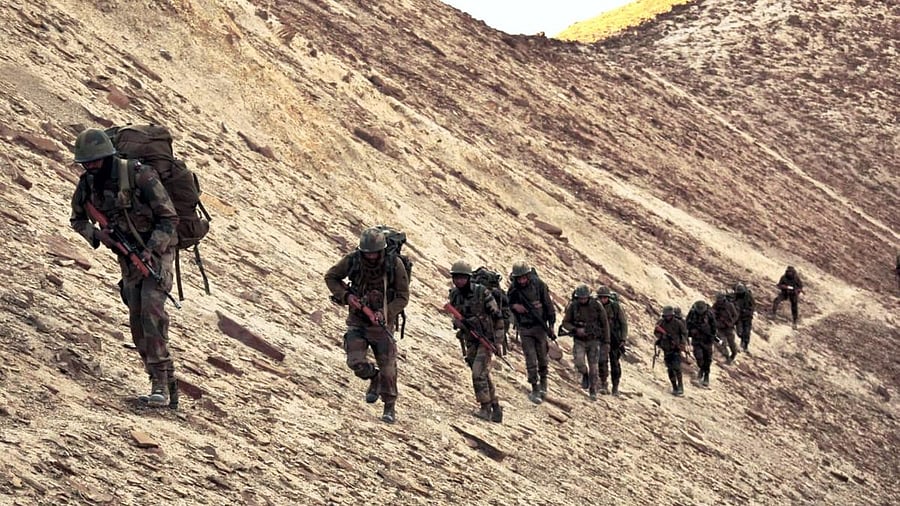
Indian Army's personnel during Exercise Parvat Prahar in eastern Ladakh.
Credit: PTI File Photo
Srinagar: More than five years after the Galwan Valley clash exposed the brutal realities of high-altitude soldiering, India is attempting something that could permanently alter its Himalayan defence posture — bringing round-the-clock grid electricity to military posts along the Line of Actual Control (LAC) in eastern Ladakh.
Ladakh’s frontier is a world where temperatures dive to –40°C, oxygen thins by half, and winds scream across 16,000-foot ridges. Forward posts at Daulat Beg Oldie (DBO), Chumar, Demchok and Pangong Tso remain cut off for months, surviving on diesel generators that freeze at night and solar panels that falter under snow.
In June 2020, these mountains became the site of the Galwan Valley clash, the first deadly encounter on the India-China border in 45 years, which claimed 20 Indian lives. The violence, and the massive military build-up that followed, highlighted one fundamental truth — logistics can decide strategy.
The grid plan
To tackle this challenge, the Ladakh Power Development Department (LPDD), backed by the Union Power Ministry, has drawn up a plan to extend grid-based electricity to all feasible Army and Indo-Tibetan Border Police (ITBP) posts by 2027.
Officials said the Power Grid Corporation of India Ltd (PGCIL) will lay transmission lines across most sectors, while LPDD engineers will handle the toughest stretch — the DBO sector, just short of the Karakoram Pass, India’s northernmost military station.
Preliminary surveys are nearing completion and statutory clearances, including from the Wildlife Department for areas near Chang Chenmo Valley, are in the final stage. “It’s an engineering feat at 16,000 feet, but technology now allows us to reach there,” an official said.
Reliable electricity is no longer a comfort but a combat multiplier. Grid power will support 24-hour surveillance radars, secure data networks, satellite communication terminals, and heating systems that currently run at partial load, he said. It will also allow rapid charging of drones and battery-based sensors, essential for real-time monitoring of Chinese troop activity.
A retired Army officer who earlier served in Ladakh said uninterrupted power “changes the operational equation entirely — we can monitor, communicate, and respond without worrying about fuel logistics or generator downtime.”
From diesel to deterrence
Today, every litre of diesel reaching a forward post travels over hundreds of kilometres through landslide-prone mountain roads or is flown in at enormous cost. In severe winters, fuel lines freeze and even helicopters struggle in thin air. A shift to grid electricity could slash operational costs, cut carbon emissions, and free the logistics chain for ammunition and rations.
Officials said the move also aligns with the government’s broader vision of making Ladakh India’s first carbon-neutral Union Territory, complementing ongoing investments in solar and hydel power.
The 2020 confrontation in Galwan was a watershed. India responded with an infrastructure blitz — new bridges over the Shyok and Galwan rivers, upgraded airstrips at Nyoma and Thoise, and accelerated road-building under the Border Infrastructure Development Programme.
Yet, power remained the weakest link. “A soldier may have a satellite phone, but if the generator fails at minus 30, he’s cut off,” the retired Army officer said. “Grid power will be as decisive as new roads or aircraft.”
Challenges on the ice
Engineers, however, warn of formidable hurdles: permafrost-laden soil, avalanche-prone valleys, and short working windows between May and October. Transmission towers must be anchored on rock, not frozen ground, and cables designed to withstand ice loads. Delays in environmental clearances could push completion beyond deadline, officials admit.
Still, the ambition reflects a new strategic confidence — one that blends sustainability with security.
India’s military modernisation in Ladakh is increasingly intertwined with civilian development. Roads built by the Border Roads Organisation (BRO) now double as supply lines for local villages; telecommunication upgrades serve both the Army and residents. Grid power will continue to overlap — a rare case where national defence directly enhances local resilience.